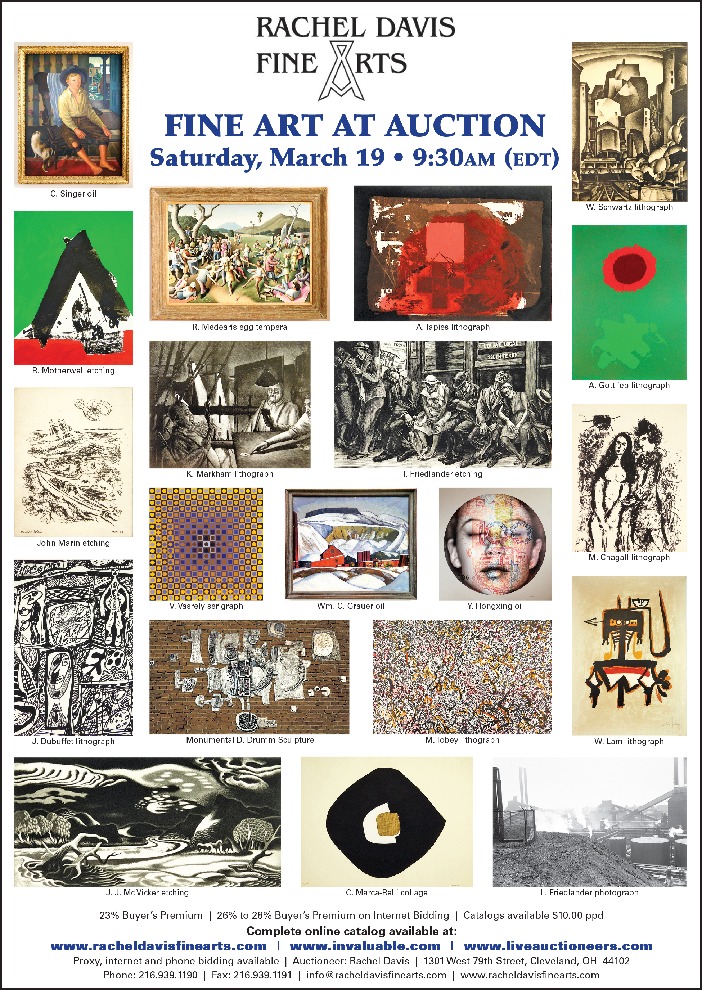Events
Home / Events

Rachel Davis Fine Arts Auction
Sat Mar 19, 2022 - Sat Mar 19, 2022
1301 West 79th Street - Cleveland, OH
Rachel Davis Fine Arts Auction
Saturday, March 19 at 9:30am (EDT)
1301 West 79th Street, Cleveland, OH 44102
www.racheldavisfinearts.com
info@racheldavisfinearts.com
Phone: 216.939.1190
Fax: 216.939.1191
CLEVELAND, OHIO — Two diverse works representing the art of 1969 will be featured in Rachel Davis Fine Arts’ March 19 auction American Regionalism exuberantly intersects the counterculture of the 1960s in Roger Medearis’ “The Flower Children.” The coupling of an artistic style associated with anachronistic nationalism with a subject that openly defied that spirit might seem asynchronous. Anything but contentious, Medearis’ 1968-69 tempera on canvas panel copiously captures the phenomenon of the “love-in,” with pedantic detail in gentle hues. In the artist’s own words, he “wanted to get to the essence of what was going on — not to editorialize but simply to record it.” “The Flower Children” will be one of the featured lots at Rachel Davis’ spring fine art auction at the firm’s gallery.
Roger Medearis (1920-2001) joined the ranks of the Regionalists at the bidding of the movement’s leader, his fellow Missourian Thomas Hart Benton. As Benton’s star student between 1938 and 1941 at the Kansas City Art Institute, Medearis readily adapted his teacher’s precise, deliberate methodology: careful preparatory sketches leading to the creation of a three-dimensional clay model, in full vibrant color. The process insured solidity to the figures and accuracy to the entire two-dimensional scene in the final painting, evident in Medearis’ 1941 tempera portrait of his grandmother “Godly Susan,” currently in the collection of the Smithsonian. Benton honed his student’s virtuosity as a draftsman, a skill that Medearis took into his service in the Navy during World War II. After the war, Regionalism ceded the art market to the New York School and Abstract Expressionism. Unwilling to acquiesce to this trend, Medearis laid down his brushes and took up a job in sales. Ironically, it was the insurgent energy of America in the late 1960s that brought the traditionalist back to his art form. For three decades, Medearis prolifically created paintings, bronzes, drawings, lithographs; ever the avowed Regionalist, he expertly carried this distinctive American style to the end of the Twentieth Century.
“The Flower Children” announces Roger Medearis’ return to painting. He articulately chronicles his experience in his artist statement. Early in 1968, he made repeated trips to the Los Angeles’ Griffith Park, the site of spontaneous “hippie gatherings,” self-proclaimed love-ins. The artist forensically gathered visual information, building during each subsequent visit: The crowd augmenting at midday, musical instruments, dominated by the beat of makeshift drums, sleeping, dancing, cheap wine, day-old bread, flowers everywhere. As he notes, “There is an endless variety of all ages, races, pets, costumes, slogans, symbols…I found repeatedly the basic situation: drummers, dancers, spectators, drifters.”
Medearis translated this “basic situation” into the motif for “The Flower Children.” Starting in July 1968, he reverted to the intentional methodology acquired from Benton, creating preparatory drawings and a clay model, all of which inform the finished work in its composition, tonal values, voluminous figures, as recorded details and patterns are sacrificed for simplification of form, a hallmark of Regionalism. Medearis documented that he devoted 700 hours to “The Flower Children,” which measures 28 by 40 inches. He completed the painting in March 1969. But he was not yet ready to leave the Griffith Park hippies at that point. In 1987, he inventively revisited the love-in by casting the scene in a cold-painted bronze.
The auction offers Medearis’ finished tempera “The Flower Children” and three of his preliminary sketches, signed by the artist and finished to ensure their preservation. Medearis’ process is revealed as we see a conservative artist’s lyrical view of the radical, conveyed without judgment, even with a touch of fascination.
Iconic, Akron Ohio-based artist Don Drumm expertly pioneered the use of cast aluminum as a provocatively appealing sculptural medium in the early 1950s. His experimentation reached a level of technical virtuosity, in concept and execution, as evidence by a 1969 abstract work made of aluminum and resin. Both whimsical and monumental (approximately 8 by 9 feet depending on configuration), the 1969 abstract celebrates Drumm’s command of materials as he explored a Surrealist vernacular in form combined with textural variety in surface, from delicate to Brutalist. A masterpiece by a home-grown master, the 1969 abstract justifies Drumm’s stature as an inventive artist of international renown.
Rachel Davis Fine Arts is at 1301 West 79th Street. For information, 216-939-1190 or www.racheldavisfinearts.com.
V. Vasrely serigraph
Wm. C. Grauer oil
Y. Hongxing oil
R. Medearis egg tempera
Monumental D. Drumm Sculpture
M. Tobey lithograph
K. Markham lithograph
I. Friedlander etching
A. Tapies lithograph
W. Schwartz lithograph
W. Lam lithograph
R. Motherwell etching
M. Chagall lithograph
L. Friedlander photograph
John Marin etching
J. J. Mc Vicker etching
J. Dubuffet lithograph
C. Singer oil
C. Marca-Relli collage
A. Gottlieb lithograph
23% Buyer’s Premium | 26% to 28% Buyer’s Premium on Internet Bidding | Catalogs available $10.00 ppd. Complete online catalog available at: www.racheldavisfinearts.com, www.invaluable.com, www.liveauctioneers.com

Antiques and The Arts Weekly is the nation’s leading weekly publication on the antiques and the arts trade, and is available both in print and online.
Each issue average between 100-200 pages and includes reporting on auctions, antiques shows and the arts while providing a platform for both buying and selling.
We have been providing breaking news and important information on the world of antiques and the arts since Publisher R. Scudder Smith started Antiques and The Arts Weekly back in 1963.
Contact
LOCATED AT:
5 Church Hill Road / Newtown, CT 06470
HOURS:
Mon - Fri / 8:00 am - 5:01 pm
PHONE:
(203) 426-8036

